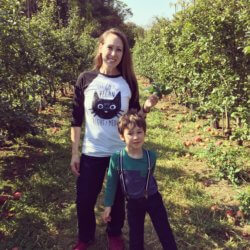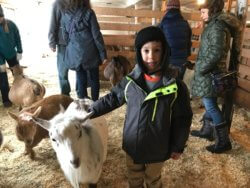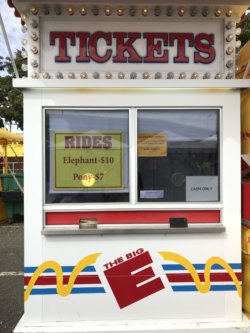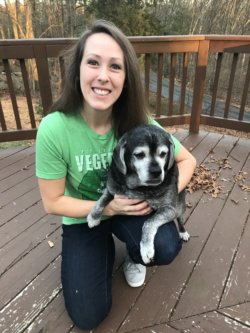In September, the Connecticut-based traveling circus that has imprisoned and exploited our elephant clients Beulah, Karen, and Minnie for decades once again transported nonhuman animals to West Springfield, Massachusetts to serve as human entertainment at the Big E, a fair attended by over a million people each year.
Also each year, animal activists from groups such as Western Mass. Animal Rights Advocates and CompassionWorks International protest outside the venue and speak out for all the nonhuman animals who suffer there. After a troubling photo of Minnie giving rides at the fair went viral, we talked to local media about the elephants’ suffering as legal “things” with no rights and our ongoing litigation on their behalf.
That same weekend, a humane educator named Abby Power went to the Big E for an assignment for an Animal Protection course she was taking. Understandably, she found the experience profoundly disturbing but not without hope for change, as she wrote about in this powerful blog post. I had the pleasure of talking to Abby to find out more about what the Big E was like for her, how it impacted her, and why she supports the NhRP:
Again, thank you so much for bearing witness and being a voice for Minnie and the many other nonhuman animals exploited at the Big E. What was the class assignment that brought you there, and how did the experience differ from what you expected going in?

Abby: I’m currently pursuing a Master of Arts in Humane Education. This program explores the connections between human rights, environmental ethics, and animal protection. The goal is to create solutionary thinking so that we are able to begin to identify inhumane and unsustainable systems and develop solutions that are healthy and just for people, animals, and the environment.
This semester I am taking a course in Animal Protection. One of our assignments was to go on a field trip to investigate the normative conditions under which animals are used. We were told to pay special attention to the conditions in which the animals are kept, how the animals appeared (“nervous,” “playful,” “bored,” etc.), and what was hidden from our view—what isn’t being shown to the general public. We could choose any for-profit business (a research laboratory, factory farm, circus, etc.) to visit. I chose to go the Big E (Eastern States Exposition) in West Springfield, Massachusetts because I knew that it would be a place where I would uncover a myriad of animal exploitation and be able to use my time there as an educational experience that I could share with my son and with many other people.
Before going to the Big E, I knew it was going to be a difficult day. I find animal exploitation abhorrent. I prepared myself as best as I could. The work I was doing on September 22nd was for the animals, to share their stories, and in order to do that I had to put myself in the position of an undercover investigator. I didn’t anticipate just how much animal exploitation I was going to encounter while I was there. From the R. W. Commerford & Sons attraction with Minnie and other animals, the circus, the animals penned and tied up in the livestock building, to the food booths filled with animal products, animal exploitation was everywhere, much more than I could have anticipated. I was also shocked nobody else seemed to be experiencing the same feelings I was. It felt like I was in the Twilight Zone.
Your son accompanied you to the fair. What was his reaction to what he saw? As a humane educator, what is your vision for how we can encourage children (and adults!) to care about other species without depriving individual nonhuman animals of their liberty or exploiting them?
Abby: My son, James, is such a sweet and kind little boy. He’s five now and has been vegan since he was three years old. When he was three, he boldly came into the kitchen and exclaimed, “I am never, ever, ever eating ‘ammimals’ ever again! It is so rude!” He spoke with so much conviction, more than most adults. My heart sang for him. That’s when I knew he was going to be a voice for the animals.
I decided to bring him with me to the Big E because he’s had very little interaction with animals being used as entertainment. It was the perfect opportunity to let him observe what was going on and talk to him about how he felt about it.
I think his reaction was very natural for a young child. He adored seeing all of the animals, Minnie in particular. I saw the wonder in his eyes. When we were observing Minnie, he commented that everyone was getting the opportunity to ride on her and that he wanted to do the same. This allowed me to open up the discussion of why it’s not fair on Minnie if we rode her. I asked him how he thought Minnie was feeling. Did she look happy? Did she look scared? He replied that she looked sad. We watched her for a while and he could see how tired she appeared. He then asked why other people were riding her. I replied that some people don’t understand why riding her hurts her but that’s why we are here. We’re here to show people that although it may seem like an innocent day out, it’s at the expense of these animals’ well-being.
I believe that children have a natural love and consideration for animals. Their curiosity is truly endearing. We need to capture that curiosity and create a lifelong learning environment where we are talking about these issues in age-appropriate ways. We need to foster children’s development of compassion, equality, and consideration for animals so that these qualities don’t disappear due to social conditioning.

I find that opening up a discussion can lead to some amazing discoveries in the minds of children. Ask them questions and propose scenarios. When observing Minnie or any other animal in captivity I may ask: “Where do you think her mommy is?” “Do you think she misses her family?” “Minnie is from Thailand, I wonder why she is at this fair?” “Why do you think she is here?” “I know that if we were separated, I would miss you so much.” “I wonder why we do this to animals.” The dots start to connect themselves. It really is about planting seeds. Having children come to their own conclusions opens the door to critical thinking, and I think that is such an important skill that we need in our society.
A great amount of change happens between generations; that’s why I believe we need to start with the children. What a great opportunity we have. We need to teach about equality for human animals, nonhuman animals and our home, planet Earth. As Carol Adams and Ginny Messina write in Protest Kitchen, “Inequality hinders compassion because it’s harder to feel compassion when you see yourself as superior to someone else” (Adams & Messina, 2018, p. 114). Once we open up our hearts to all, our compassion can begin to grow.
The key is ending injustice, period. Once we start to uncover the invisible and sometimes visible connected systems of injustice, the barriers can begin to crumble.
How did you get involved in animal advocacy, and why do you support the NhRP’s elephant rights litigation seeking freedom and sanctuary for Beulah, Karen, and Minnie?

Abby: My advocacy is driven by speaking up for what’s right and just. Once I saw the endless abuse and use of nonhuman animals that our species partakes in, I knew I couldn’t be silent. If I was in the position of Minnie, I know that I would want someone to speak for me.
It’s really interesting because I’m an introvert, a people-pleaser. I hate conflict and I’m not always confident in conversation. When I first began I really questioned my abilities to speak up for the animals. How in the world would I be able to advocate on the animals’ behalf when I wasn’t fit to be an activist? I learned that this was absolutely not the case. Advocacy comes in all forms. Whatever gift you have, I believe you can use it towards advocating for the animals. All it takes is one person to speak out.
I first came across the Nonhuman Rights Project in one of my first assignments in my Animal Protection class. During a film festival we watched Steven Wise’s TED Talk, “Chimps have feelings and thoughts. They should also have rights.” What Steven was saying really resonated with me. I then went on to watch Unlocking the Cage, and that’s when I learned more about what NhRP is doing and I knew that I had to be part of it. The Nonhuman Rights Project is another example of effective advocacy. We see lawyers using their talents to speak for the animals. What I think is so unique about the NhRP is the fight towards the recognition of personhood and rights. What a better way to create systematic change. Because a win for Minnie, Tommy, or Happy means an eventual win for all animals.
You write that you feel newly empowered after this experience. We’re glad to hear that! How did you feel beforehand, and what do you see yourself doing next as an animal advocate and in your professional life?
Abby: Prior to my field trip assignment to the Big E, my advocacy mainly focused on being a voice for the animals in the livestock industry. However, after meeting Minnie and all of the other animals who were being used as entertainment, my focus has now broadened. All deserve consideration and our support no matter how they are being used.
I have so many ideas as to how I want to move forward in my activism. I love trying new things with the goal of reaching different groups of people. I’m active in direct outreach groups such as Anonymous for the Voiceless, but I also love to do outreach in the form of education. I give a lot of presentations to different communities on topics ranging from the benefits of plant-based diets to why caring for human rights means caring for the animals. I think education is key. When you come from a place of compassion, other people are more open to receive your message. My strategy is not to blame or shame anyone. Like I mentioned before, everyone is born with that innate sense of compassion towards animals, we just have to rediscover it.

I have a dream of creating a center for social change, a place where we can cultivate compassionate change and fight all injustice (for humans, animals, and the planet). It could be a place for the community to come: children, adults, activists, artists, and anyone who wants to use their talents to speak up for marginalized groups. I envision a place where we could collaborate and create solutionary ideas in order to make systematic change. I want to strike at the root of problems and ask the questions no one has ever asked before. I want to design a space that uses creativity, education, and advocacy to change the world. Until this day comes, I will continue to stand up to injustice, whatever that injustice may be.
You end your blog post by asking your readers to look into the eyes of the nonhuman animals depicted in your photos and videos. Why do you think it’s important to do this?
Abby: Many believe that humans are more evolved, that we are more intelligent and therefore superior because we have a developed language; this is an ableist view. What they forget is that every species has their own way to communicate.
Most people have never made a connection with a nonhuman animal before. They don’t understand speciesism and it’s not their fault. Our society has been so conditioned to not see it. It’s an invisible system but the more we talk about it, and show people why what we do to animals is not right, the more people have the opportunity to make more humane decisions. This is why looking into the eyes of nonhuman animals is so important.
It’s when we look into their eyes that we can’t deny their sentience, and a connection is possible. You see that they are a living, breathing being, just like us. Our eyes tell our story. We can tell when someone is happy, sad, frustrated, angry or scared. This doesn’t stop at our own species. There’s so much we can learn by looking into their eyes. It’s our common language.
I love that, in addition to animal advocacy, environmental protection, and social change, your public speaking focuses on helping people find joy in life. Why is this an important component of your work and worldview? What are some of the things that bring you joy in a world where human and nonhuman animal suffering is so prevalent?
Abby: There is a Buddhist quote by Dōgen Zenji that I love and try to emulate in my life.
It goes like this:
“Wake up! Wake up! Life and death are of supreme importance. Time swiftly passes by and opportunity is lost. Each of us should strive to awaken. Awaken! Take heed, do not squander your life.”
Like many people, I have had my fair share of challenges. My dad died in June of 2016 at the age of 57 from a heart attack. I was devastated. He was the one person who always lifted me up and encouraged me not to be afraid of living life with passion. Through these challenges, I have learned that my passion in life is to inspire greatness in others, to fight for social justice, and to encourage people to live a life filled with joy.
It’s incredibly freeing when you are not afraid to go for what you want. You may not remember what someone told you but you will never forget how they made you feel. When people think of me, I hope they smile and found that I shared with them warmth and kindness.
After my dad died, I decided I needed to change my life and really start living. I went to the park for my typical run but as I was listening to my music I felt the urge to start dancing. Usually, I would suppress the urge and get on with my run but not this time. I took a deep breath and started dancing as I ran. I absolutely love to dance so why not dance? What’s stopping me? The people I passed in the park looked confused at first but quickly lent me a smile and a laugh. That was two years ago and I haven’t stopped. If feeling a little bit embarrassed for thirty minutes means that I brighten up someone’s day, so be it! Maybe it will give them the courage to live their joy too. I refuse to squander my life. I have the privilege of having one while so many people and animals do not.
Sometimes it does take the unimaginable and something that feels so insurmountable to know what you are capable of, and we are capable of so much. As activists it’s also so important to practice self-care. I practice self-care by gardening, dancing, meditating, and spending time with my wonderful husband and son. It’s essential each person finds what brings joy into their life, that’s the stuff that will keep us going. Our life is based on constantly going against the stream and fighting injustice. It can take its toll and there are days where we may feel helpless and like we’re not making a difference but we are.
It’s important to remember … just when the caterpillar thought the world was ending, she became a butterfly.
Thank you Abby!
Please sign and share the NhRP’s petition calling on the Commerford Zoo to free Beulah, Karen, and Minnie to an elephant sanctuary and join the NhRP outside the DCU Center in Worcester, MA on February 2nd to rally for their freedom. That weekend, the Commerford Zoo will bring its animal-exploiting “kids fun fair and zoo” to the 14,800-capacity arena. During the rally, we’ll give updates on our lawsuits and other efforts to obtain rights for autonomous nonhuman animals. Following the rally, we’ll hold a candlelight vigil in honor of Beulah, Karen, and Minnie. During the vigil, artist Colleen Plumb will exhibit her acclaimed Thirty Times a Minute video projection, which shows dozens of captive elephants in zoos caught in unending cycles of stereotypic behavior and bearing the weight of an unnatural existence in their small enclosures. Learn more about the event on the sharable event page. We look forward to seeing you there!